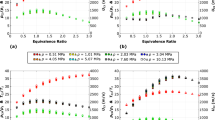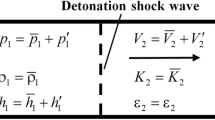Abstract
The influence of various chamber geometries on shock wave reflections near the head end of rotating detonation engines was investigated. A hydrogen/air one-step chemical reaction model was used. The results demonstrated that the variation in flow field along the radial direction was not obvious when the chamber width was small, but became progressively more obvious as the chamber width increased. The thrust increased linearly, and the detonation height and the fuel-based gross specific impulse were almost constant as the chamber width increased. Near the head end, shock waves reflected repeatedly between the inner and outer walls. Both regular and Mach reflections were found near the head end. The length of the Mach stem increased as the chamber length increased. When the chamber width, chamber length and injection parameters were the same, the larger inner radius resulted in more shock wave reflections between the inner and outer walls. The greater the ratio of the chamber width to the inner radius, the weaker the shock wave reflection near the head end. The detonation height on the outer wall and the thrust, both increased correspondingly, while the specific impulse was almost constant as the inner radius of the chamber increased. The numerical shock wave reflection phenomena coincided qualitatively with the experimental results.
















Similar content being viewed by others
References
Mahmoudi, Y., Mazaheri, K.: High resolution numerical simulation of the structure of 2-D gaseous detonations. Proc. Combust. Inst. 33, 2187–2194 (2011)
Roy, G.D., Frolov, S.M., Borisov, A.A., Netzer, D.W.: Pulse detonation propulsion: challenges, current status, and future perspective. Progr. Energy Combust. Sci. 30(6), 545–672 (2004)
Li, Q., Fan, W., Yan, C.J.: Experimental investigation on performance of pulse detonation rocket engine model. Chin. J. Aeronaut. 17(1), 9–14 (2004)
Voitsekhovskii, B.V.: Stationary detonation. Dokl. Akad. Nauk SSSR 129(6), 1254–1256 (1959)
Nicholls, J.A., Cullen, R.E., Ragland, K.W.: Feasibility studies of a rotating detonation wave rocket motor. J. Spacecr. Rockets 3(6), 893–898 (1966)
Bykovskii, F.A., Zhdan, S.A., Vedernikov, E.F.: Continuous spin detonation. J. Propuls. Power 22(6), 1204–1216 (2006)
Bykovskii, F.A., Zhdan, S.A., Vedernikov, E.F.: Continuous spin detonation of hydrogen-oxygen mixtures. 1. Annular cylindrical combustors. Combust. Explos. Shock Waves 44(2), 150–162 (2008)
Wolanski, P., Kindracki, J., Fujiwara, T.: An experimental study of small rotating detonation engine. In: Roy, G.D., Frolov, S.M., Sinibaldi, J. (eds.) Pulsed and continuous detonations, pp. 332–338. Torus Press, Moscow (2006)
Kindracki, J., Wolanski, P., Gut, Z.: Experimental research on the rotating detonation in gaseous fuels-oxygen mixtures. Shock Waves 21, 75–84 (2011)
Zhdan, S.A., Bykovskii, F.A., Vedernikov, E.F.: Mathematical modeling of a rotating detonation wave in a hydrogen–oxygen mixture. Combust. Explos. Shock Waves 43(4), 449–459 (2007)
Davidenko, D.M., Gokalp, I., Kudryavtsev, A.N.: Numerical study of the continuous detonation wave rocket engine. AIAA paper 2008–2680 (2008)
Hishida, M., Fujiwara, T., Wolanski, P.: Fundamentals of rotating detonation. Shock Waves 19(1), 1–10 (2009)
Yi, T.H., Lou, J., Turangan, C., Choi, J.Y., Wolanski, P.: Propulsive performance of a continuously rotating detonation engine. J. Propuls. Power 27(1), 171–181 (2011)
Shao, Y.T., Wang, J.P.: Change in continuous detonation wave propagation mode from rotating detonation to standing detonation. Chin. Phys. Lett. 27(3), 034705 (2010)
Shao, Y.T., Wang, J.P.: Continuous detonation engine and effects of different types of nozzle on its propulsion performance. Chin. J. Aeronaut. 23(6), 647–652 (2010)
Zhou, R., Wang, J.P.: Numerical investigation of flow particle paths and thermodynamic performance of continuously rotating detonation engines. Combust. Flame 159, 3632–3645 (2012)
Schwer, D. A., Kailasanath, K.: Feedback into mixture plenums in rotating detonation engines. AIAA paper 2012–0617 (2012)
Uemura, Y., Hayashi, A.K., Asahara, M., Tsuboi, N., Yamada, E.: Transverse wave generation mechanism in rotating detonation. Proc. Combust. Inst. 34(2), 1981–1989 (2013)
Pan, Z.H., Fan, B.C., Zhang, X.D., Gui, M.Y., Dong, G.: Wavelet pattern and self-sustained mechanism of gaseous detonation rotating in a coaxial cylinder. Combust. Flame 158, 2220–2228 (2011)
Schwer, D.A., Kailasanath, K.: Numerical study of the effects of engine size on rotating detonation engines. AIAA paper 2011–581 (2011)
Lee, S.H., Jo, D.R., Choi, J.Y.: Effect of curvature on the detonation wave propagation characteristics in annular channels. AIAA paper 2008–988 (2008)
Nakayama, H., Moriya, T., Kasahara, J., Matsuo, A., Sasamoto, Y., Funaki, I.: Stable detonation wave propagation in rectangular-cross-section curved channels. Combust. Flame 159, 859–869 (2012)
Eude, Y., Davidenko, D.M., Gokalp, I.: Use of the adaptive mesh refinement for 3D simulations of a CDWRE (continuous detonation wave rocket engine). AIAA paper 2011–2236 (2011)
Ma, F.H., Choi, J.Y., Yang, V.G.: Propulsive performance of air breathing pulse detonation engines. J. Propuls. Power 22(6), 1188–1203 (2006)
Balsara, D.S., Shu, C.W.: Monotonicity preserving weighted essentially non-oscillatory schemes with increasingly high order of accuracy. J. Comput. Phys. 160(2), 405–452 (2000)
Author information
Authors and Affiliations
Corresponding author
Additional information
Communicated by F. Lu.
Rights and permissions
About this article
Cite this article
Zhou, R., Wang, JP. Numerical investigation of shock wave reflections near the head ends of rotating detonation engines. Shock Waves 23, 461–472 (2013). https://doi.org/10.1007/s00193-013-0440-0
Received:
Revised:
Accepted:
Published:
Issue Date:
DOI: https://doi.org/10.1007/s00193-013-0440-0




